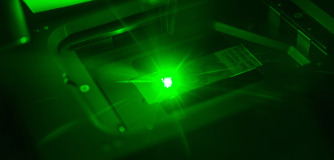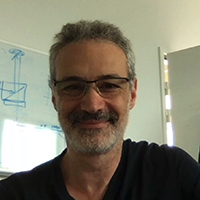The Cellular Imaging platform allows the access to a confocal microscope (spinning disk S-M4D), a video-microscope (V-M4D), a super-resolution microscope (SMLM SR-M4D) and a flow-cytometer (VYB). The instruments are optimised to study living cells, and fluorescent protein expression. Details are available on the ISBG website.
Our flow-cytometer (VYB, Miltenyi biotec) is installed within a L2 facility (room 547C), and equipped with three diode lasers and 8 fluorescence channels. It is optimized for fluorescent proteins detection, and covers all the emission wavelengths used with the epi-fluorescence and confocal microscopes of the cell imaging facility. It is fully programmable (automated labelling and sample manipulation) and is compatible with multi-well plate. A dedicated workstation for analysis is also available for users.
The confocal spinning disk microscope (S-M4D) is optimized to study living cells. It is installed in room 547B and has been upgraded in May 2022 (GATACA systems). It is composed of an epifluorescence Olympus IX81 microscope equipped with plan-apo 20x dry, 40x dry and oil, and 60x and 100x immersion objectives (with wide numerical apertures) and with differential interference contrast (Nomarski). This inverted and fully motorized microscope is equipped with an incubation chamber and with a CO2 controled microenvironmental chamber for live imaging. MetaMorph (Molecular devices) is used for controlling the microscope. Imaris (Bitplane) and Volocity (Quorum Technologies) are also available to users on a specific workstation for post acquisition analysis.
The SAFe360 microscope from Abbelight and Olympus (SR-M4D). This new microscope was installed on the M4D imaging platform in 2021 and aims to reinforce our super-resolution capabilities (PALM/ STORM/ PAINT and single particle tracking). The microscope allows 2D/3D multicolor imaging of fixed and living cells with a resolution of few tens of nanometers, as well as single particle tracking experiments with a localization precision up to 5-10 nm for bright organic fluorophores. The system is equipped with a laser combiner (405 nm, 488 nm, 532 nm, 561 nm, 640 nm et 730 nm), a module for homogeneous EPI/HiLo/TIRF illumination and two sCMOS Hamamatsu Fusion cameras offering a large field of view and high acquisition speeds (more than 100 frames per second). The microscope is highly automated and controlled via the NEO software. For a more detailed information you can contact us or visit the manufacturer’s website: https://www.abbelight.com/solutions/abbelight-instruments/#SAFe360
The video-microscope (V-M4D) is installed in room 547C. It is composed of an epifluorescence Olympus IX83 microscope equipped with plan-apo 20x (dry), 40x, 60x and 100x immersion objectives (with wide numerical apertures) and with differential interference contrast (Nomarski). This inverted and fully motorized microscope has been installed within an incubation chamber (Digital Pixel) set at 37°C for live imaging. Volocity (Quorum Technology) is used for controlling the microscope and for treatment of the acquisitions.
The spinning disk confocal microscope (S-M4D; Olympus and GATACA) has been upgraded in May 2022. It is configured with a Nipkow disk (Yogokawa CSU-X1) and 6 solid state lasers for confocal imaging in real time on living cells (very low phototoxicity). Acquisition is performed using an EMCCD camera (Andor iXon ultra ; MetaMorph). A photoconversion/photoactivation module is available for FRET and FRAP (Ilas2).
The time-lapse video-microscope (V-M4D, Olympus), renewed in 2019, is composed of an inverted Olympus IX83 fully motorized microscope equipped with a blind, temperature controlled, incubation chamber (Digital Pixel) for live imaging. Acquisition is achieved with a sCMOS camera (Hamamatsu Orca Flash4; CellSens).
The multi-channel flow-cytometer (VYB, Miltenyi biotech) is equipped with three lasers and 8 fluorescence channels. It is optimised for fluorescent proteins, and covers all the emission wavelengths used with microscopy. It is automatable (multiwell plate, immuno-staining, dilutions), and compatible with magnetic columns Miltenyi (isolation of rare events).
Cytometry and microscopy analysis software are available for users in a dedicated room. Three workstations are installed with Volocity and Imaris for microscopy data visualization and analysis; or MacsQuant and CellQuest for flow cytometry.



